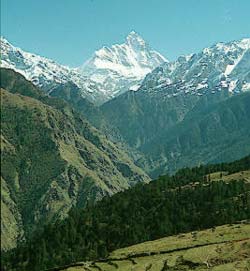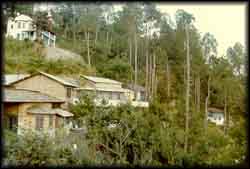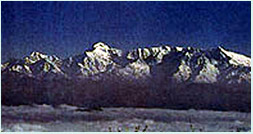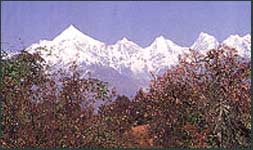|
Travelogues Kumaon Remembered
|
|||||||||||||||||||||
The Kumaon hills have a timeless beauty and an eloquent grandeur. I went there as a stranger and spent three idyllic years, only to return again and again in home-coming. If belonging is not a fact of birth, but of a bonding born of freedom and the fullness of living, I am never closer to home than when I am there. I have walked, ridden pillion and driven through these hills till they remain etched forever to be re-lived in dreams. The pre-historic rock paintings at Lakhu Udyan in the Binsar Gad Valley are proof of human civilisation from the earliest times. The first known reigning dynasty was of Kunindas between 500 B.C. to 600 A.D., followed by the Katyuri dynasty in the 7th century. Modern Kumaon is credited to the Chand Dynasty, and the foundations of Almora in the heart of Kumaon, were laid in the 17th century. |
More on Uttarakhand • Corbett Park Travelogues • Discovering Auli Impressions • Almora • Nainital Trekking • Pilgrim's Trail • Gangotri - Gaumukh - Tapovan | ||||||||||||||||||||
 Naini Tal (tal = lake), the most popular hill resort of the region was 'discovered' by the British in 1841, and was subsequently used as the summer capital of the United Provinces. A lake resort surrounded by seven hills, legend has it that the lake was formed when the goddess Sati lost her sight here, and was carried by Lord Shiva. A popular hill resort all year round, in the summer, crowds jostle each other as they walk around the lake, crowd the restaurants, photograph themselves straddled on horses, romance in rowing boats, paddle boats and sail yachts, and sometimes walk through pine and deodar forests to the nearby hilltops, Naina Peak, Snow View, Dorothy's Seat and Kilbury.
Naini Tal (tal = lake), the most popular hill resort of the region was 'discovered' by the British in 1841, and was subsequently used as the summer capital of the United Provinces. A lake resort surrounded by seven hills, legend has it that the lake was formed when the goddess Sati lost her sight here, and was carried by Lord Shiva. A popular hill resort all year round, in the summer, crowds jostle each other as they walk around the lake, crowd the restaurants, photograph themselves straddled on horses, romance in rowing boats, paddle boats and sail yachts, and sometimes walk through pine and deodar forests to the nearby hilltops, Naina Peak, Snow View, Dorothy's Seat and Kilbury.
Less developed Bhim Tal, Naukuchia Tal and Sat Tal nearby offer variations of the same theme of lakes in the hills. Corbett National Park in the foothills of the Shivalik mountains is a wild-life sanctuary. Mukhteshwar provides a fantastic semi-circular view of the Himalayan ranges. The more adventurous seek out the lesser known retreats or undertake a trek to the snow-bound peaks and the glaciers. In the summer the hills are familiar and friendly. For those who seek the Kumaon hills beyond the tourist attractions they will find a tangible sense of history and the warmth of a people with lofty ideals and simple pleasures. There is a palpable vibration in the stillness of the Himalayas that have led many to seek the quietude and the solitude of their minds that are reflected in these hills. And of the many places I have loved in Almora district, here are but a very few :
Through these narrow lanes an unique procession snakes it's way in celebration of Dussehra, the festival that celebrates the triumph of good over evil. Ravana, Kumbh Karan and some 20 giant figurines painstakingly created for days, are paraded through the town before the effigies are burnt in the central football field, witnessed by the entire town and the people from several nearby villages who assemble for the event. A few kilometres away from the main town is the temple of Chitai, where resides the presiding deity, Golu, believed to be a general of a Chand king, who was later deified as a form of Bhairava. The local people come here in celebration, at the beginning of anything auspicious and in supplication. The thousands of bells in different shapes and sizes that adorn the precincts of this simple temple are witness to the prayers that have been fulfilled here. Elsewhere the Nanda Devi temple and the temple at Kasar Devi where Swami Vivekananda meditated and realised cosmic unity, are tucked away in secluded corners, away from the bustle of daily living. On the way to Kasar Devi is Cranks Ridge named after the people who have at one time or another lived here, including Lama Govinda, the Austrian born scholar of Tibetan Buddhism and his Parsi born wife Li Gotami, and the Danish born Sorensen who was given the initiatory name, Sunyata by Maharshi Ramana who called him a "rare born mystic." Psychiatrist and writer R.D. Laing and psychedelic hippie hero Tim Leary are only among the many who have lived here. The view of the Himalayas from Apworth and Snow View Estates, and further down the road from Kalimat is spectacular. On the other side of town, Bright End Corner is named for it's ring-side view of the sun-set.
Binsar 30 km from Almora, provides a breath-taking semi-circular view of the Himalayas. The verdant forest has leopards, bear, pheasants, fox and other wild life. Totally isolated at 2400 metres, the winters are cold and it snows. Now on the tourist map with the opening of a Kumaon Mandal Vikas Nigam guest house, when we first visited the place as a guest at an estate there, we parked our motor-cycle in a clearing near a kutir (hut) in the gathering dusk of winter, and stopped to ask the sadhu (ascetic) living there, the path that led to the estate.
Jageshwar, 35 kms from Almora in a beautiful wooded valley in the midst of a deodar (pine) forest is Jageshwar, believed to be one of the 12 Jyotir Lingas. A cluster of 164 sculpted temples built by successive rulers over an extended time period is located near a small lake called Brahma Kund, whose waters are believed to be sacred. A few kms away is Panuanaula, where the Mirtola Ashrama is situated. Here Yashoda Mai lived and her British disciple Sri Krishna Prem wrote The Yoga of the Bhagwad Gita and The Yoga of the Kathopanishad, among several other renowned works. Legend has it that several centuries ago, when Jageshwar was almost inaccessible, several yogis lived and meditated here. Even to-day, without the constant stream of visitors that pour into better known places of worship, the atmosphere here has the deep solemnity of meditation rather than the supplication of worship. Kausani 2000 metres above sea-level, 54 kms of a truly picturesque road away from Almora, Kausani is possibly best known because of Mahatma Gandhi's deep attachment to the place. The road winds it's way beside the Kosi river, past the terraced villages of Someshwar, famous for it's Shiva temple, and it's view of Trishul, emerging between two nearby hills which obliterate the other peaks. Grossly over-crowded in the summer and autumn, Kausani is idyllic in winter. Here, one has a 300 km view of the Himalayan ranges. 17 kms away is the frequented temples of Baijnath, dating to the 12th and 13th centuries. A splendid example of the Katyuri art of temple architecture, there is a perfect image of the goddess Parvati in the main temple, preserved from the ravages of time and theft, which have robbed the other temples. On Shiva Ratri it is the site of a major festival.
14 kms away is Berinag, an otherwise nondescript interior village town from where the view is spectacular. 27 kms from here are the underground caves at Patal Bhuvaneshwara, with stalactite and stalagmite formations. According to mythology, this was the home of the gods, Bhuvaneshwara, Mahadeva and Shesha Nag. The caves were believed to have been discovered by a Suryavanshi king, who stumbled into them during a hunting expedition, when he was chasing a deer. Spending several years here, it is believed he attained enlightenment and the rare gift of having every wish fulfilled. Completely dark and dank, with the most spectacular natural formations, that have to be viewed by torch-light, a visit to these caves is an experience in itself. Entering on hands and knees into the bowels of the earth, it is a re-visitaion and conquest of primitive fears. Folklore has it that many rishis lived and meditated in the extensive catacombs here, and Kumaonis undertake the journey as a pilgrimage towards enlightenment. Yesterday I received a letter from a 70 year old friend who lives alone in Almora, and with whom we spent many hours over endless cups of tea. She writes, " Adjustment is the key to joy. I am exactly where you left me. It will not be difficult to find me when we meet." And that in essence is what Almora means to me - I too am exactly where I was every time I return, though in the meanwhile I have travelled long and wide.
|
|||||||||||||||||||||
Editor: Romola Butalia (c) India Travelogue. All rights reserved. |
|||||||||||||||||||||
 But winter is the time to view the majestic Himalayas romanced by the rising and setting sun. It is a time to be enthralled by the clear azure daytime skies and to trace the Milky Way in the inky skies of night. November to January is the time to visit the Kumaon hills and be captivated forever by the spectacular view of the high Himalayas in the invigorating crisp cold air, and experience their silence and stillness. In February the icy cold winds chill the bones, and only summer can thaw them. The mist at the bottom of the valleys clear with the late rising sun, you can watch the long shadows of a short afternoon, be mesmerised by the amber flames that crackle and pop on a winter evening. Winter is the time to experience the hills in their lesser known aspect, splendid in their remote solitude.
But winter is the time to view the majestic Himalayas romanced by the rising and setting sun. It is a time to be enthralled by the clear azure daytime skies and to trace the Milky Way in the inky skies of night. November to January is the time to visit the Kumaon hills and be captivated forever by the spectacular view of the high Himalayas in the invigorating crisp cold air, and experience their silence and stillness. In February the icy cold winds chill the bones, and only summer can thaw them. The mist at the bottom of the valleys clear with the late rising sun, you can watch the long shadows of a short afternoon, be mesmerised by the amber flames that crackle and pop on a winter evening. Winter is the time to experience the hills in their lesser known aspect, splendid in their remote solitude.

 When we left Almora and I was shutting the house a last time, the elderly lady from whom we had rented the cottage we lived in, and who had become one of my closest friends, stopped me saying, "It is a custom with us that when the daughter of the house goes to her new home, the doors here are not shut till she reaches." Ever since then, every time we have arrived un-announced, from a distance she spots us, and the piping hot cup of spiced tea, so customary in the hills is ready before we can wind our way down the hill.
When we left Almora and I was shutting the house a last time, the elderly lady from whom we had rented the cottage we lived in, and who had become one of my closest friends, stopped me saying, "It is a custom with us that when the daughter of the house goes to her new home, the doors here are not shut till she reaches." Ever since then, every time we have arrived un-announced, from a distance she spots us, and the piping hot cup of spiced tea, so customary in the hills is ready before we can wind our way down the hill.
 It is difficult to find the way in the dark. You will get lost in the forest. I will take you there," he offered, suggesting we warm ourselves with a cup of tea first. Sitting in the smoke-filled room chatting while we drank tea, night had fallen. With a fading torch, we followed the sadhu, who carried a trident in his hand, chanting loudly to dispel his own fears as he desperately hunted and lost the overgrown path several times, before we finally arrived at our destination. The next day our hosts showed us the pug-marks and leavings of the leopard who also uses that trail. Many moons later we met the same sadhu on yet another trail. Greeting us warmly, he said, "Meeting again is a symbol of love."
It is difficult to find the way in the dark. You will get lost in the forest. I will take you there," he offered, suggesting we warm ourselves with a cup of tea first. Sitting in the smoke-filled room chatting while we drank tea, night had fallen. With a fading torch, we followed the sadhu, who carried a trident in his hand, chanting loudly to dispel his own fears as he desperately hunted and lost the overgrown path several times, before we finally arrived at our destination. The next day our hosts showed us the pug-marks and leavings of the leopard who also uses that trail. Many moons later we met the same sadhu on yet another trail. Greeting us warmly, he said, "Meeting again is a symbol of love."
 From Chaukori the snow-capped peaks are seemingly but a rapt breath away. Bordering the district of Pithoragarh, 125 kms away from Almora, the journey is via Bageshwar, situated at the confluence of the sacred rivers Saryu and Gomti. Here, the mountainside is dotted with tea gardens. 3 kms away a pathway ascends steeply leading to a deer park, with a herd of rare musk deer, amidst lush green forests.
From Chaukori the snow-capped peaks are seemingly but a rapt breath away. Bordering the district of Pithoragarh, 125 kms away from Almora, the journey is via Bageshwar, situated at the confluence of the sacred rivers Saryu and Gomti. Here, the mountainside is dotted with tea gardens. 3 kms away a pathway ascends steeply leading to a deer park, with a herd of rare musk deer, amidst lush green forests.